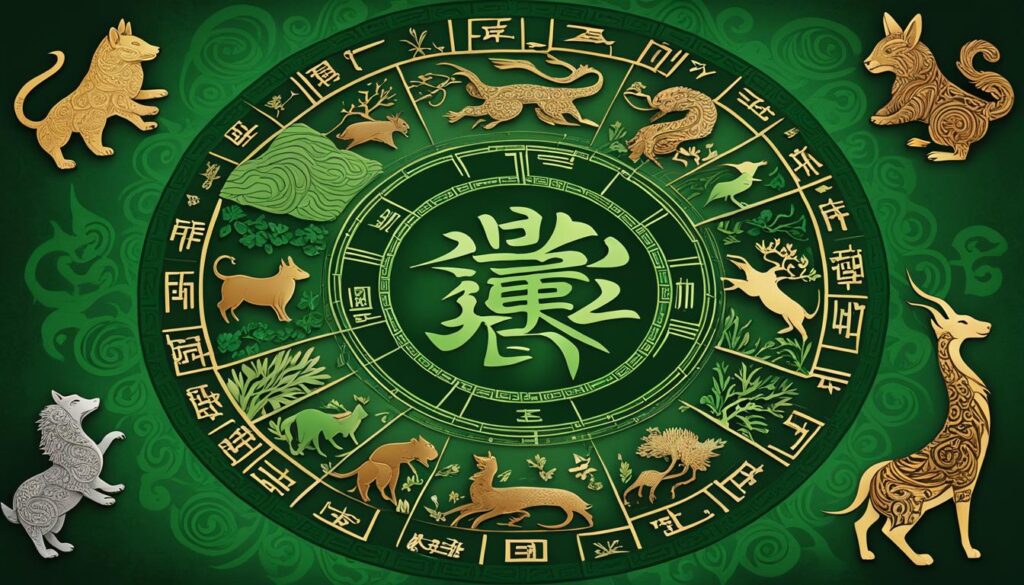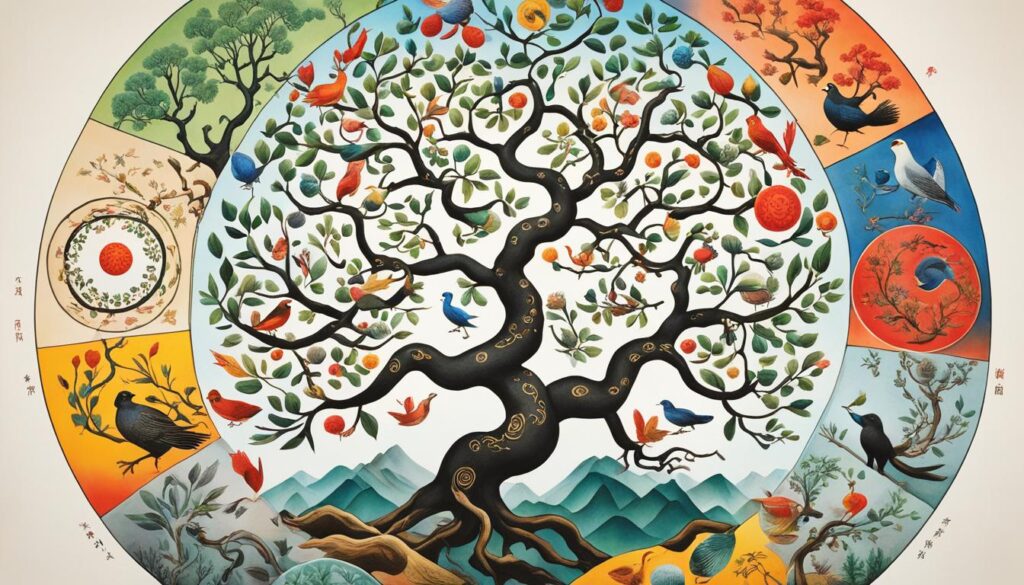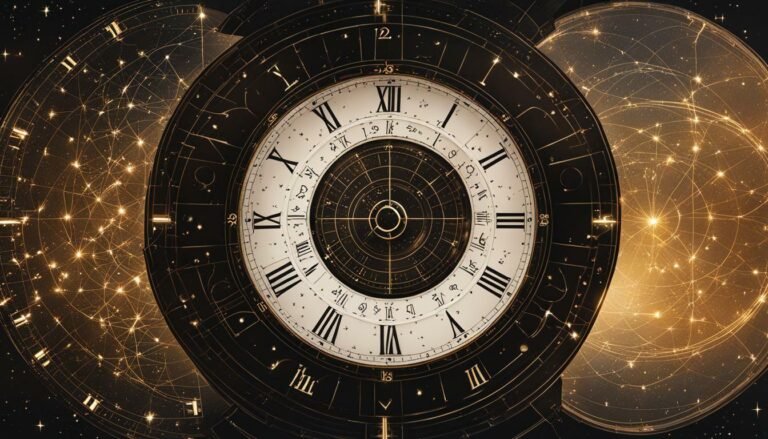In Chinese Astrology, What Are The 12 Earthly Branches?
As you delve into the mystical world of Chinese astrology, you’ll encounter the 12 Earthly Branches, an ancient yet ever-relevant system that unveils insights into your destiny. This celestial code not only anchors the Chinese zodiac but also intricately weaves through the fabric of time, guiding your journey through life. The branches—represented by familiar animals like the Rat, Ox, Tiger, and others—are not just zodiac signs in Chinese astrology; they are symbols of cosmic synchronicity and personal fate.
Understanding the roles these branches play is essential to grasp the depths of your zodiac signs, as each branch aligns with specific traits and fortunes that can influence your path. So, whether you’re a spirited Dragon or a steadfast Ox, the 12 Earthly Branches hold the key to deciphering the stars’ wisdom and the elemental forces at play in your chart.
Key Takeaways
- Discover the role of the 12 Earthly Branches in shaping the Chinese zodiac.
- Unravel the connection between your birth sign and your personality in the context of Chinese astrology.
- Explore how the Earthly Branches influence your destiny and societal traditions.
- Gain insights into the synchronization of time, elements, and zodiac signs Chinese astrology offers.
- Appreciate the cultural and historical significance of the Chinese zodiac animals associated with these branches.
Exploring the Foundation of Chinese Astrology
As you delve into the realm of Chinese astrology, you’ll discover that it is underpinned by a collection of intricate systems that shape its forecasts and insights. The 12 Earthly Branches emerge as fundamental components in this fascinating form of divination. It’s a blend of the celestial and the elemental, mingling time increments with natural forces and the Chinese zodiac. For centuries, these relationships have provided a framework to fathom the ebbs and flows of destiny and personality.
Each element and zodiac animal within this system carries a wealth of significance. The charismatic Dragon breathes fire and exuberance into its year, while the steadfast Ox offers a period of reliability and strength. These embodiments are not merely characters in a mythical narrative; they are reflections of the dynamic interplay between the Chinese astrology elements and human characteristics.
The impact of these elements and zodiac signs goes beyond mere symbolism; they actively shape annual Chinese astrology predictions, playing a crucial role in guiding individuals through the decisions and challenges of everyday life. Through the cyclical dance of the branches, one can glean insights into personality traits, the potential for prosperity, and even the unfolding of personal and global events.
- The assertive Dragon, representative of pure vigor
- The diligent Ox, embodying the essence of steadiness
- The clever Rat, symbolizing strategic acumen
- The harmonious Rabbit, bringing tranquility and peace
In this exploration, we’ll also unearth connections between these ancient Chinese astrology predictions and how they resonate with your personal life journey. Whether it’s understanding the elemental influence on your zodiac sign or determining the most auspicious days for your endeavors, these branches serve as a beacon for navigating life’s seas.
Ready to explore how these branches can inform your decisions and color your worldview? Keep reading, and you’ll soon find yourself woven into the rich tapestry of Chinese astrology that’s as predictive as it is reflective.
Historical Significance of the 12 Earthly Branches
When you explore the depths of the Chinese astrology chart, you uncover a tapestry woven through time, where celestial movements became the keystones of destiny. The 12 Earthly Branches, each associating with one of the chinese astrology 12 animals, stand as silent guardians of history and harbingers of individual fate. Let’s delve into the origins of these astrological segments and discover how they have charted the course of human culture.
Origins in Ancient Astronomy
Peering into the night sky, the sages of ancient China traced the orbit of Jupiter, christening it the “Year Star”. They segmented its near 12-year orbit into 12 distinct parts, laying the groundwork for the Earthly Branches system. This celestial calculation, approximated to a full 12 years, played a pivotal role in establishing the framework of the Chinese astrology chart and anchoring the temporal cycles mirrored in human lives. Influencing everything from individual personality to the cosmic order, these intervals rendered Jupiter not just a planet but a marker of time and tradition.
Adoption in Calendrical Systems
The sagacity of these ancient astronomers led to the adoption of the Earthly Branches within China’s timekeeping systems, a synthesis of astronomy and culture that persists to this day. Engrained deeply in the traditional Chinese calendar, these branches transcended their celestial origins to denote months, days, and hours, intricately linking the ebb and flow of cosmic cycles with the pace of earthly existence. For every marked hour and every turned page of the calendar, the Earthly Branches affirmed their relevance, resonating through the fabric of societal norms and ritualistic practices.
From Celestial Observations to Cultural Practices
The transition from the heavens to human culture saw the Earthly Branches transcend mere measurements of time. They became the sculptors of cultural identity, shaping everything from the folklore-enshrined race of the zodiac animals to the precise two-hour periods that composed the Chinese day. These branches, rich in symbolism and utility, carved out an ecological niche in traditional Chinese units of time and directionality. Their significance, once tied to the movements of stars, became as tangible as the flow of seasons and as intimate as the ticking of a clock.
Engaging with these ancient symbols, you, as a curious observer, encounter a lineage that extends beyond the stars. In every zodiac sign, each denoted by one of these 12 branches, lies an element of this rich history. While the Chinese astrology chart may foretell your destiny, it’s the Earthly Branches that have shepherded civilizations towards understanding the cosmic order. Thus, wrapped within the cycle of years symbolized by the number 4, each Earthly Branch maintains its watch, an immortal relay race linking past, present, and future.
In Chinese Astrology, What Are The 12 Earthly Branches?
As you delve into the wisdom of Chinese astrology, you’ll discover the 12 Earthly Branches are much more than mere symbols. They carry rich stories, potent energies, and are intimately linked to the zodiac signs in Chinese astrology. Each branch is paired with a specific animal, embodying unique characteristics and energies that influence your personal fate and fortune within the cosmos.
- Rat: Known for its wit and resourcefulness, steering you towards intelligence in decision-making.
- Ox: Symbolizes hard work and reliability, providing a sturdy foundation for your endeavors.
- Tiger: Brings forth courage and assertiveness, encouraging you to take daring leaps.
- Rabbit: Associated with luck and empathy, guiding you to harmony in relationships.
- Dragon: Represents power and strength, offering you majestic paths to success.
- Snake: Exudes wisdom and intuition, letting you navigate life with foresight.
- Horse: Stands for freedom and passion, driving you to pursue your dreams.
- Goat: Symbolizes creativity and persistence, helping you overcome obstacles with grace.
- Monkey: Known for its cleverness and adaptability, ensuring you stay ahead of the curve.
- Rooster: Showcases tenacity and confidence, enabling you to shine in the spotlight.
- Dog: Emphasizes loyalty and honesty, creating trustworthiness in your persona.
- Pig: Illustrates generosity and indulgence, enriching your life with contentment.
These zodiac signs in Chinese astrology are further connected to cardinal directions, seasons, and elements, deepening their significance in your life. Whether you’re looking to understand your inherent traits or seeking guidance on future endeavors, the 12 Earthly Branches provide invaluable insights that intertwine with Chinese astrology predictions, helping chart a course that aligns with your zodiac’s celestial rhythm.

The Cultural Influence of Earthly Branches Across East Asia
The 12 earthly branches are more than just components of the Chinese zodiac; they’re a cultural phenomenon that has permeated the heart of East Asian traditions. As you explore this facet of Chinese astrology, you’ll discover that these elements have left a profound imprint on the region’s cultural identity, impacting everything from daily conversations to grand architectural designs.
Diverse Zodiac Interpretations
The beauty of the Chinese zodiac lies in its flexibility, allowing neighboring cultures to weave their unique threads into the broader astrological tapestry. In Vietnam, for instance, the transformation of the ox into the water buffalo and the substitution of the rabbit with the cat reflect how these symbols seamlessly adapt to local context, adding richness to the 12 earthly branches that continue to guide and influence lives across borders.
Integration into Daily Life Across Regions
Imagine replacing your alphabetical references with zodiac symbols when you plan your day, make decisions, or even communicate with others. This is precisely how the 12 earthly branches blend into the daily lives of many people in East Asia, similar to how you might use letters as shorthand. This integration showcases the branches’ unceasing relevance and the enduring respect for astrological wisdom in daily modern living.
Symbolism in Traditional Art and Architecture
Exemplifying wealth, good fortune, and divine protection, the images of the Chinese zodiac animals and the principles they represent are intricately carved into the tapestry of East Asian history. They adorn ancient temples and are embossed within the art—silent but powerful testaments to the influence of the 12 earthly branches in shaping not just the temporal but also the enduring spiritual landscape of the region.
How the Earthly Branches Define Chinese Zodiac Animals
As you delve into the world of zodiac signs chinese astrology, it’s fascinating to discover how the Earthly Branches serve as the pivotal framework for the Chinese zodiac system. Each zodiac animal fits into a 12-year cycle that’s reflective of Jupiter’s journey across the sky. It’s this celestial pattern that assigns the animals their roles and influences within Chinese astrology.
- Rat: Known for their resourcefulness and flexibility, individuals born under the Rat sign are seen as industrious and clever.
- Ox: Those represented by the Ox are often characterized by their strength and reliability, much like their animal counterpart.
- Tiger: Tigers in the zodiac are brave and competitive, often taking the lead with enthusiasm and courage.
- Rabbit: A figure of calm and grace, the Rabbit embodies serenity and gentle manners.
- Dragon: With its mythical grandeur, the Dragon symbolizes power and luck, portraying individuals as charismatic and flamboyant.
- Snake: Snakes are seen as wise and mysterious, often associated with intuition and insight.
- Horse: The Horse’s spirit translates into a zodiac sign full of energy and passion for freedom.
- Goat: The Goat’s gentle nature is a harbinger of creativity and peace within the zodiac spectrum.
- Monkey: Clever and curious, the Monkey signifies a quick-witted and lively personality.
- Rooster: The Rooster’s confidence and punctuality resonate in individuals who are methodical and independent.
- Dog: Loyal and honest, those born in the year of the Dog are deeply trusted and considered sincere.
- Pig: With their easy-going and generous traits, Pigs signify fortune and happiness in Chinese astrology.
Your own zodiac sign, according to chinese astrology 12 animals, doesn’t just offer predictions; it outlines a distinct identity that is believed to guide your life’s journey. These astrological alignments offer insights into personality traits, life’s challenges, and even potential successes. Whether you’re a fiery Dragon or a steadfast Ox, the Earthly Branches contribute to painting a detailed picture of your character within the grand narrative of destiny.
Interactions With the Heavenly Stems
As you journey deeper into the realms of Chinese astrology, you’ll encounter the fascinating interplay between the 12 Earthly Branches and the 10 Heavenly Stems. This partnership creates a dynamic cosmic rhythm that not only structures the traditional Chinese calendar but also steers chinese astrology predictions. It’s a celestial dance that intricately weaves through time and imparts wisdom onto human life under the continuous cycle known as the sexagenary sequence.

Picture this: an elaborate system where each year is characterized not just by an Earthly Branch but by its relationship with a Heavenly Stem. This combination forms a distinct energetic blueprint that recurs every 60 years, a period that ancient astrologers deciphered to map out life’s intricacies and cosmic alignments.
Creating the Sexagenary Cycle
A step into the sophisticated Chinese timeline reveals how each year is uniquely named by pairing one of the 12 animals of the Earthly Branches with one of the 5 elemental energies associated with the Heavenly Stems. Think of it as a puzzle that, when put together, paints a clear picture of the universe’s ebb and flow for every passing year. This 60-year cycle is much more than a perpetual calendar—it’s the heartbeat of Chinese cosmology, influencing countless aspects of life, from agriculture to personal fortune.
Interpreting Earthly Branches and Stems in Personal Astrology
Now, let’s zoom in to a personal level. The melding of Earthly Branches with Heavenly Stems is pivotal in crafting your Four Pillars of Destiny, or Bazi. This system delves into the depths of one’s birth chart, deciphering the nuances of destiny down to the hour of birth. Through Bazi, you’ll discover how these astrological elements synergize to map out your personality traits, forecast life milestones, and identify opportune moments, all through the lens of chinese astrology predictions.
This profound confluence of time measurement and personal fate, encoded in the structure of the traditional chinese calendar, has endured for centuries. It’s a philosophy centered on the number 8, symbolizing harmony and balance, which resonates through each aspect of your astrological profile, ensuring that the wisdom from the stars remains at the heart of Chinese cultural tradition and daily life.
Understanding the 12 Earthly Branches in Daily Contexts
The traditional Chinese calendar and Chinese astrology’s 12 animals have far-reaching impacts on the routines and rituals you partake in daily. Even with the fast pace of modern life, these time-honored elements still find their place, helping you to navigate the subtleties of each day with a deeper connection to ancient wisdom. You might be surprised to find that the 12 Earthly Branches are not just relics of the past, but active tools that shape everything from personal scheduling to cultural customs.
- Acting as a historical backbone for the traditional Chinese calendar, the 12 Earthly Branches delineate time with precise intention, influencing when to engage in certain activities or celebrate particular occasions.
- For those who follow Chinese astrology, the practice of consulting the zodiac animals associated with the Earthly Branches can provide guidance on everything from business decisions to personal relationships.
- The branches further serve as symbolic gateways to understanding ancestral heritage and maintaining a lifestyle that is harmoniously aligned with the cosmos.
As you check the calendar for a favorable day to begin a new project or prepare for a traditional festival, you’re participating in a legacy that has been meticulously crafted over millennia, rooted in the movements of the heavens and the Earthly Branches.
Therefore, whether you’re scheduling an important event or seeking insight into your own nature, the 12 Earthly Branches offer you a vibrant tapestry of symbolism and functionality. These ancient markers continue to guide individuals toward auspicious times and act as conduits for the enduring wisdom of Chinese astrology’s 12 animals in your everyday contexts.
Elemental Associations of Each Earthly Branch
When you delve into the realm of Chinese astrology, you’ll discover that each Earthly Branch is intricately connected to specific chinese astrology elements, imbuing every zodiac sign with dynamic qualities that reflect Yin or Yang polarities. This alignment with elements like Wood, Fire, Earth, Metal, and Water is far from random; it serves to enrich the traditional interpretations of the zodiac signs chinese astrology is known for.
These elements don’t just influence your personality; they’re believed to affect your life’s journey, as well. Recognizing these associations helps you to appreciate the underlying forces at play within the intricate tapestry of the cosmos as presented by Chinese astrology. Moreover, understanding these connections can be the key to unlocking insights into your own nature and destiny.
Understanding Zodiac Elements and Polarities
Each of the twelve branches pairs with the five elemental energies to create a comprehensive system that goes beyond mere animal symbols. This provides a nuanced layer to each sign, enabling a balanced approach to interpreting someone’s character and life path, as it is influenced by the alternating currents of Yin and Yang.
The Body and Time Correlations
The influence of the chinese astrology elements extends further, bridging physical aspects and temporal periods known as ‘shichen.’ These two-hour intervals are governed by the Earthly Branches and are thought to resonate with specific parts of the body, symbolizing the unison of human life with the rhythm of the universe. Such wisdom is not only integral to understanding your zodiac profile but also plays a role in shaping various practices found in the traditional chinese calendar.
As the number 10 suggests in numerology, representing completion and cosmic order, the interconnectedness of the Earthly Branches, elements, and the balance of Yin and Yang encapsulate a holistic cosmos perfectly reflected in the wisdom of Chinese astrology.
Practical Applications of Earthly Branches in Modern Times
As you navigate through the nuances of Chinese astrology, it’s fascinating to see how the traditional elements, such as the Earthly Branches, find their place in today’s world. These ancient symbols, which carry the weight of wisdom from the traditional Chinese calendar, are not relics of the past but continue to serve functional roles in society. Let’s explore how they’re used not only in Korea and Japan but globally to connect us with the lore of the 11 stars that guide our fate.
Coding Systems in Formal Documents
Imagine sorting through important paperwork and finding a code that’s ancient yet so efficient it’s used in formal documentation. That’s right, in some East Asian countries, the Earthly Branches have replaced alphabetical codes to uniquely identify various aspects of official documents. This system showcases the adaptability and persistence of these symbols, intricately woven into the fabric of modern legalities and administrative tasks, ensuring that even as times change, the connection to centuries-old traditions remains unbroken.
Contemporary Uses in Astrology Predictions
In a world where the future seems as uncertain as ever, the Earthly Branches offer a beacon, informing chinese astrology predictions with their rooted meanings. Astrologers today apply these symbols to decipher the complexities of destiny, providing you with insights and laying out the best times for life-changing decisions. Whether you’re choosing a wedding date or launching a business venture, the Earthly Branches intertwine the rich tapestry of the past with your current life’s rhythms, directing toward harmonious outcomes.
As we continue to appreciate the mysteries of the skies, the practical applications of the Earthly Branches remind us of the timelessness of astrology. They persist, echoing through the corridors of time, to guide you just as they have guided generations before. In the heart of every prediction or code lies the spirit of the traditional Chinese calendar— a spirit that remains alive, ready to help you navigate the intricate dance of your personal and professional life.
Advanced Directions and Navigation Using Earthly Branches
When you explore the traditional chinese calendar, you’re engaging with more than just dates and festivals; you’re stepping into a world where the 12 earthly branches reign supreme. This ancient time-keeping system transcends its historical confines, offering precise navigational guidance that astonishes with its complexity and accuracy.
- Keen mariners and seasoned pilots employ these branches, developing advanced compasses that extend beyond the conventional 4-cardinal point system.
- The unparalleled precision of the branches only grows when they are expanded to a 24 or 48-point compass, an essential tool that has charted courses through the ages.
In the hands of experts, the 12 earthly branches are not mere symbols but instruments of direction and time, harmonized to guide voyages indispensable to both the legacy and future of East Asian navigation.
Conclusion
In navigating your path through the complexities of life, the 12 Earthly Branches of Chinese astrology offer a distinctive compass. This profound system syncs with the rhythmic expansion of the cosmos, threading through the very fabric of time — from past centuries to the present day. It shapes your understanding of personality, connects events to cosmic cycles, and even delves into the spheres of health and well-being. By exploring your place within the Chinese zodiac, you gain more than foresight; you access a holistic charting derived from an ancient practice that champions a balanced and insightful life journey.
As you delve deeper into the Chinese zodiac, you witness how the celestial narrative interlaces with the terrestrial; how these Earthly Branches, far from being mere symbols, are vibrant threads weaving the grand tapestry of fate. They encapsulate the wisdom of ages — charting a course that not only predicts but informs and enriches life’s many dimensions. Whether considering aspects of your own character or seeking out the auspicious in everyday life, the influence of these astrological traditions is as enduring as it is dynamic.
Therefore, as you consider the place of these ancient branches in contemporary times, it becomes clear that their allure lies in their immutability amidst constant evolution. Rooted in the historical and blooming in the modern, the legacy of the 12 Earthly Branches persists, guiding us through the renewal of seasons and the unfolding of stars. Let the lessons impregnated in these astrological symbols serve as your timeless guide in a world of endless transformation.
FAQ
In Chinese Astrology, What Are The 12 Earthly Branches?
The 12 earthly branches in Chinese astrology are a series of symbols that traditionally correspond to 12 animals and are used to record the time sequence: Rat, Ox, Tiger, Rabbit, Dragon, Snake, Horse, Goat, Monkey, Rooster, Dog, and Pig. These branches, alongside the 10 Heavenly Stems, make up the components of the sexagenary cycle used in Chinese calendars, astrology, and cosmology.
How do the 12 Earthly Branches relate to Chinese astrology predictions and elements?
The 12 Earthly Branches not only represent zodiac animals but also interact with five elements of Wood, Fire, Earth, Metal, and Water, as well as the concept of Yin and Yang. This composite structure contributes to an individual’s astrological chart and informs predictions, personality traits, and elemental balances within Chinese astrology.
What is the historical significance of the 12 Earthly Branches?
Historically, the 12 Earthly Branches were based on observations of Jupiter’s orbit and were used as time markers in the traditional Chinese calendar. They evolved from there to become significant cultural symbols, shaping calendrical systems and influencing various aspects of life from relational compatibilities to directional guidelines.
How have the 12 Earthly Branches impacted cultural practices across East Asia?
The cultural influence of the Earthly Branches extends across East Asia, seen in the diverse interpretations of zodiac animals across different cultures and their integration into everyday life, from the way time is expressed to their presence in traditional art and architecture.
How do the Earthly Branches define the Chinese zodiac animals?
Each of the 12 Earthly Branches is affiliated with a Chinese zodiac animal, which shapes the personality descriptions and destiny readings within the cycle of the zodiac. They determine the characteristics and fortunes of individuals according to the year of their birth within the 12-year cycle.
What is the interaction between the Earthly Branches and the Heavenly Stems?
The Earthly Branches interact with the 10 Heavenly Stems to form the sexagenary cycle, which incorporates a combination of animal signs and elemental attributes that span a 60-year cycle. This system is used in Chinese astrology to map out personal fortunes and characteristics.
How are the 12 Earthly Branches used in daily contexts?
The 12 Earthly Branches are used in daily contexts as a traditional method for marking time, from days to hours. They also guide choices for determining auspicious times for various activities, reflecting their continued relevance in day-to-day life and the traditional Chinese calendar.
What are the elemental associations of each Earthly Branch?
Each Earthly Branch is associated with one of the five elements and a Yin or Yang polarity, offering a nuanced interpretation of how these forces interact with each zodiac sign. These associations impact the traits and life outcomes of individuals according to Chinese astrology.
What are some practical applications of Earthly Branches in modern times?
In modern times, the Earthly Branches are used as a coding system in formal documents in some East Asian countries and continue to play a role in Chinese astrology for making predictions. They also serve as a framework for navigation, showcasing their adaptability and continuous relevance.
How do Earthly Branches aid in advanced directions and navigation?
The Earthly Branches have extended their use from the traditional 12 cardinal points to more complex navigational systems such as the 24 and 48-point compasses, aiding mariners and pilots in precise directional guidance based on this deep-rooted Chinese system.







